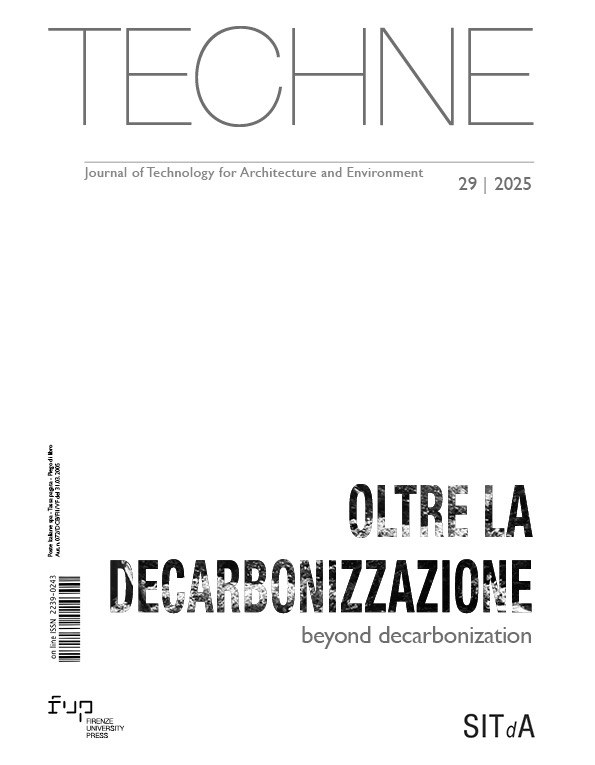Published 2025-07-31
Keywords
- Urban heat island,
- Nature-based solutions,
- Multi-objective optimisation,
- Key performance indicators,
- Climate adaptation
How to Cite
Copyright (c) 2025 Francesca Mosca, Gabriele Oneto, Martina Guasco, Katia Perini

This work is licensed under a Creative Commons Attribution 4.0 International License.
Funding data
-
Ministero dell'Università e della Ricerca
Grant numbers PRIN PNRR 2022 program - D53D23020090001
Abstract
This paper aims to define a methodological framework and an operational approach for optimising the location, shape, and size of trees (or other NbS) within the surrounding urban morphology to locally reduce the urban heat island (UHI) effect and identify correlations between urban configurations and NbS performance. The goal is to overcome current limitations, which include the lack of a systematic approach to maximising NbS performance in locally mitigating UHI. Based on the model of the urban canyon, the proposed theoretical and computational approach includes the definition of key performance indicators and their calculation to implement a multi-objective optimisation.
Downloads
References
- Augusto, B. et al. (2020) ‘Short and medium- to long-term impacts of nature-based solutions on urban heat’, Sustainable Cities and Society, 57, pp. 102-122. Available at: https://doi.org/10.1016/j.scs.2020.102122 (Accessed on 13/09/2024). DOI: https://doi.org/10.1016/j.scs.2020.102122
- Biocca, M., Gallo, P. and Sperandio, G. (2022) ‘Potential Availability of Wood Biomass from Urban Trees: Implications for the Sustainable Management of Maintenance Yards’, Sustainability, 14(18), pp. 11226. Available at: https://doi.org/10.3390/su141811226 (Accessed on 13/09/2024). DOI: https://doi.org/10.3390/su141811226
- Competence Centre of Foresight (2020), Available at: https://knowledge4policy.ec.europa.eu/foresight_en (Accessed: 04/09/2024).
- Boudali Errebai, F. et al. (2022) ‘Impact of urban heat island on cooling energy demand for residential building in Montreal using meteorological simulations and weather station observations’, Energy and Buildings, 273, pp. 112410. Available at: https://doi.org/10.1016/j.enbuild.2022.112410 (Accessed on 01/09/2024). DOI: https://doi.org/10.1016/j.enbuild.2022.112410
- European Commission (2022). Nature-based solutions. Available at: https://research-and-innovation.ec.europa.eu/research-area/environment/nature-based-solutions_en (Accessed: 4 September 2024).
- Fernandes, R. et al. (2023) ‘Local Climate Zones to Identify Surface Urban Heat Islands: A Systematic Review’, Remote Sensing, 15(4), pp. 884. Available at: https://doi.org/10.3390/rs15040884 (Accessed on 01/09/2024). DOI: https://doi.org/10.3390/rs15040884
- IPCC (2021), Climate Change 2021: The Physical Science Basis. Available at: https://www.ipcc.ch/report/ar6/wg1/downloads/report/IPCC_AR6_WGI_Full_Report.pdf (Accessed: 25 August 2024).
- Jin, S. et al. (2023) ‘Comprehensive evaluation of carbon sequestration potential of landscape tree species and its influencing factors analysis: implications for urban green space management’, Carbon Balance and Management, 18(1), pp. 17. Available at: https://doi.org/10.1186/s13021-023-00238-w (Accessed on 20/08/2024). DOI: https://doi.org/10.1186/s13021-023-00238-w
- Kim, S.W. and Brown, R.D. (2021) ‘Urban heat island (UHI) variations within a city boundary: A systematic literature review’, Renewable and Sustainable Energy Reviews, 148, pp. 111256. Available at: https://doi.org/10.1016/j.rser.2021.111256 (Accessed on 01/09/2024). DOI: https://doi.org/10.1016/j.rser.2021.111256
- Kundzewicz, Z.W. and Matczak, P. (2012) ‘Natural risks: mitigation and adaptation’, Ecohydrology & Hydrobiology, 12(1), pp. 3–8. Available at: https://doi.org/10.2478/v10104-012-0005-3 (Accessed on 20/09/2024). DOI: https://doi.org/10.2478/v10104-012-0005-3
- Knapp, S. and MacIvor, J.S. (2023) ‘Nature-based solutions and biodiversity: synergies, trade-offs, and ways forward’, in T. McPhearson, N. Kabisch, and N. Frantzeskaki (eds) Nature-Based Solutions for Cities. Edward Elgar Publishing, pp. 82-103. Available at: https://doi.org/10.4337/9781800376762.00014 (Accessed on 01/09/2024). DOI: https://doi.org/10.4337/9781800376762.00014
- Makki, M., Showkatbaksh, M. and Song, Y. (2019), “Wallacei Primer 2.0”. Available at: https://www.wallacei.com/ (Accessed: 4 July 2024).
- Marando, F. et al. (2022) ‘Urban heat island mitigation by green infrastructure in European Functional Urban Areas’, Sustainable Cities and Society, 77, pp. 103564. Available at: https://doi.org/10.1016/j.scs.2021.103564 (Accessed on 01/08/2024). DOI: https://doi.org/10.1016/j.scs.2021.103564
- Marrone, P. and Orsini, F. (2018) ‘Resilience and open urban environments. Comparing adaptation and mitigation measures’, TECHNE – Journal of Technology for Architecture and Environment, pp. 348-357 Pages. Available at: https://doi.org/10.13128/TECHNE-22099 (Accessed on 01/08/2024).
- Morabito, M. et al. (2015) ‘Urban-Hazard Risk Analysis: Mapping of Heat-Related Risks in the Elderly in Major Italian Cities’, PLOS ONE. Edited by K. Dalal, 10(5), pp. e0127277. Available at: https://doi.org/10.1371/journal.pone.0127277 (Accessed on 01/09/2024). DOI: https://doi.org/10.1371/journal.pone.0127277
- Mosca, F. et al. (2021) ‘Nature-Based Solutions: Thermal Comfort Improvement and Psychological Wellbeing, a Case Study in Genoa, Italy’, Sustainability, 13(21), pp. 11638. Available at: https://doi.org/10.3390/su132111638 (Accessed on 01/08/2024). DOI: https://doi.org/10.3390/su132111638
- Muralikrishna, I. (2014), ‘Biomass Calculations for Carbon Sequestration in Forest Ecosystem’, Journal of Energy and Chemical Engineering, 2(1), pp. 30-38. Available at: https://www.researchgate.net/publication/259843856_Biomass_Calculations_for_Carbon_Sequestration_in_Forest_Ecosystem (Accessed on 25/07/2024).
- ‘Nature-based solutions can pave the way to carbon-neutral cities in 2030’ (2023) Nature Climate Change, 13(8), pp. 774-775. Available at: https://doi.org/10.1038/s41558-023-01750-0 (Accessed on 25/07/2024). DOI: https://doi.org/10.1038/s41558-023-01750-0
- Nunez, M. and Oke, T. R. (1977) ‘The Energy Balance of an Urban Canyon’, J. Appl. Meteorol. 16, 1 I-19. Oke, T. R.: 1974, Review of Urban Climatology 1968-1973, WMO Technical Note No. 134, WMO, Geneva, Switzerland. Available at: https://www.researchgate.net/publication/260784082 (Accessed on 23/07/2024). DOI: https://doi.org/10.1175/1520-0450(1977)016<0011:TEBOAU>2.0.CO;2
- Pelletier, G., Landry, D. and Girouard, M. (2016), ‘A Tree Classification System for New Brunswick’. Version 2.0. Northern Hardwoods Research Institute. Edmundston, New Brunswick.
- Perini, K., Chokhachian, A. and Auer, T. (2018) ‘Green Streets to Enhance Outdoor Comfort’, in Nature Based Strategies for Urban and Building Sustainability. Elsevier, pp. 119–129. Available at: https://doi.org/10.1016/B978-0-12-812150-4.00011-2 (Accessed on 25/07/2024). DOI: https://doi.org/10.1016/B978-0-12-812150-4.00011-2
- Salvati, A. et al. (2022) ‘Impact of reflective materials on urban canyon albedo, outdoor and indoor microclimates’, Building and Environment, 207, pp. 108459. Available at: https://doi.org/10.1016/j.buildenv.2021.108459. DOI: https://doi.org/10.1016/j.buildenv.2021.108459
- Scudo, G. and Ochoa de la Torre, J.M. (2003), Spazi verdi urbani, la vegetazione come strumento di progetto per il comfort ambientale negli spazi abitati. Sistemi Editoriali, Napoli.






